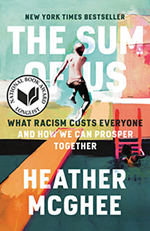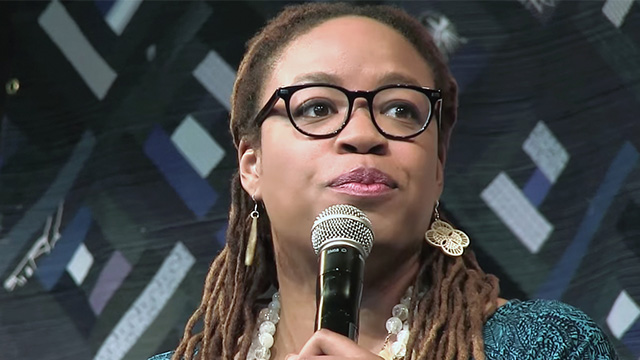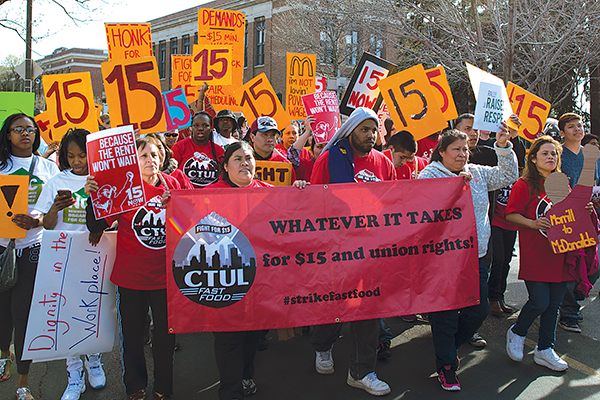The Interview
Heather McGhee
TBF News Summer 2022
It was a kind of homecoming for Heather McGhee when she came to the Boston Foundation on July 13 as the first keynote interview of the Embrace Ideas Festival. She was raised on the South Side of Chicago by her mother, Gail Christopher, a highly regarded social justice and social change agent who encouraged kitchen table conversations about politics and race. When she was just 11, her mother made the unusual and life-changing decision to send her to a small private boarding school in Deerfield, Massachusetts called Bement. She went on to attend high school at Milton Academy. In fact, her high school math teacher and boarding school dorm parents were in the room for her conversation with TBF President and CEO Lee Pelton about her book The Sum of Us: What Racism Costs Everyone and How We can Prosper Together, which she wrote after interviewing people across the country on a quest to answer the central question of why the American economy fails the American public.
LEE PELTON: Tell me about your background and how found yourself doing this work.
HEATHER MCGHEE: I grew up on the south side of Chicago. My parents got divorced when I was two. They were very different and I love them both. They’re still very much in my life. I think my mother, some of you may know is Gail Christopher was always focused on social justice and social change from a perspective of health and nutrition and then up then up stream to the social determinants of health. So, I was really lucky early on that my kitchen table conversations as a child were about the big questions: about politics, about race, about all of the things that are still the kitchen table conversations in my own family. I was an inquisitive kid (and now I have my own), who was always asking why. I was a social justice brat of sorts. I saw injustice everywhere.
And I was fortunate that my mother made the very strange decision at the time… I was a precocious kid and the year my brother was to go off to college, my mom did something that was unprecedented in Chicago: She looked into boarding schools for me. It just wasn’t the tradition in the Midwest. She found this sweet little boarding school in Deerfield, Massachusetts, called Bement, that had about 30 boarders in the whole school and then I found my way to Milton Academy. So that changed my life entirely in many different ways.
I went from the south side of Chicago in a 90 plus percent Black neighborhood to almost entirely white in Deerfield and certainly majority white in Milton. But I also went from being one of many in a public school to getting all of this attention and the incredible amount of resources that come from those schools. And I’m really cognizant of that. My high school math teacher and boarding school dorm parents are in the room right now! The Vanderoffs. And I actually gave the commencement speech on Friday. It was extraordinary. My faith in the next generation is profoundly strong and it was definitely restored by being among them.
I was only 11 at that first boarding school and that experience of multiracial humanity at such a young age and not believe the lies about white superiority… I saw that they were just as messed up as people back at home helped to lead me to some of the solutions that we have been talking about and that I write about in the book.
LP: Tell us about your experience at Demos and how that shaped your thinking.
HM: I was lucky enough to get an entry level job at Demos when I was 22 and then I was really focused on inequality in our economy and our democracy. So I came of age in that environment of advocacy and lobbying. We could study problems in the American economy, use evidence to craft solutions and then advocate for people in power to make better decisions—and that was the way to make social change. I stayed there for a long time and became president of the organization when I was about 33.
I started to feel that there was something missing in our theory of change. That there were some invisible headwinds that were holding the country back. No one really wanted to do any research into those headwinds or do anything about them. Yet these were holding us back. They were stopping us from having nice things, as I write about in the book.
Why is it so hard for us to raise the minimum wage when it’s been stagnant since the 1990s? Why do we accept so much inequality and struggle? It’s not because we don’t have the data. It’s not even because we don’t know what the solutions are. It’s because we have not been able to come together and fight for them. It’s because there is a disconnect between the people in power, whether it’s in business or government and the people who are impacted by the decisions that they make and that race is a big piece of that disconnect—that social distance—and it’s a big piece of our inability to come together and fight for the solutions that we all know we all need and would benefit us all. So that was why I left what was in many ways my dream job and hit the road. There were two different trips over the course of three years when I was pregnant and had my son, would become The Sum of Us.
LP: There was a moment in an interview you did on C-Span and a white man said that he was afraid of Black people. (Video of interview played here.)
Caller: I was hoping you could get me to change my mind about some things. I’m a white male and I am prejudiced. When I open up the papers, I get very discouraged at what young Black males are doing to each other and the crime rate. I understand that they have to get money for drugs… So I have fears. I don’t like to be forced to like people. I like to be led to like people through example. What can I do to change? To be a better American?
HM: This is one of the most important conversations we need to have in this country. We are not a country where we’re all united because we are one racial group or all descended from one tribe or one community. That is actually what I think makes this country beautiful and that is our challenge. We are the most multiracial and ethnically diverse democracy in the world. And so the question that you ask is the question for all of us—all of us of who are racially and ethnically diverse. Most of these fears and prejudices are unconscious. We all have these prejudices. And so your ability to just say that you have these fears and prejudices and I want to get over them is one of the most powerful things that we can do right now at this moment in our history, so thank you.
So what can you do? Get to know Black families who are not involved in crime and gangs—and that’s the majority. Turn off the news at night? Many media outlets over-represent African American crime and underrepresent crimes by white people. Join a church, if you are a religious person that is a Black church or a church that is interracial. Start to read about the history of the African American community in this country. Foster conversation in your family and in your neighborhood where you’re asking exactly those kinds of questions. This fear of communities that we do not live near… We are still a very segregated country. Millions of Americans live in places where they rarely see anyone of a different race and only get the worst possible news is tearing us apart. And we know that in order to be a demos that is united across lines of race and gender and age, we have to foster relationships. We have to get to know who one another actually is. We are always, as Americans, surprised when we build relationships across race.


HM: The story that I tell in the book that is a real part of history that has consequences to this day—and is a metaphor for other kinds of public goods—is the story of what happened to many of the nation’s nearly 2,000 grand resort-style public swimming pools that were built as part of a building boom of public works in the ’30s and ‘40s that came from a civic health imperative. There weren’t many air conditioners in those decades. And they were largely segregated and for whites only, either with a “whites only” sign or just by custom in places like Boston and Chicago and in the West and the Midwest, often enforced by intimidation and violence. And so these segregated pools, for me, were reflective of a deeper government ethos in the ‘30s and ‘40s that said that, ‘We’ve been through the first gilded age of inequality. We’ve been through the Great Depression. We know now that government has a right and a responsibility to ensure a decent standard of living for people, so it will provide free nice things, like these public swimming pools and bridges.
And there were things that were much more economically significant, like social security, which came out in this era. There was a massive investment in housing that workers could afford and on top of that was the unprecedented goal of mass homeownership. A working-class person could own an asset by paying off a national instrument that was government regulated and insured and have this appreciating piece of wealth. Other reflections of this “public good ethos” were strong labor laws and collective bargaining, the GI Bill that sent a generation to college for free and offered down payments on homeownership.
These public investments and public goods really worked. We had the greatest middle class the world had ever seen, the American dream, the highest standard of living in the world in the 1950s. And, as Lee described in his remarks, all those other public goods, in addition to the swimming pools, were often either explicitly racially exclusive or implicitly.
LP: All of those public goods, in addition to the swimming pools, were often either explicitly or implicitly racially exclusive.
HM: Yes, the GI Bill was race neutral on its face, but of course, there was segregated education and social security carved out and excluded the two job sectors that most Black people were in: domestic work and agricultural work. Even the labor unions were segregated. So basically you had a whites-only American dream. And when the Civil Rights Movement empowered people to sue about the public swimming pools, making the case that you’ve been benefiting from our tax dollars all these years for generations and we haven’t been benefiting from it, towns and cities began to be faced with integration orders around these swimming pools. And many places, not just places like Alabama, but places like Ohio and New Jersey and Washington and California decided to drain their public swimming pools rather than integrate them.
The Montgomery, Alabama example is just so pointed because they closed the entire Parks and Recreation Department of the city and kept it closed for a decade rather than integrate. And it was 1970 before they reopened it. In fact the Supreme Court at this point was already done with being the leader of the fight for integration and actually found that there was no problem with closing public facilities like swimming pools to avoid integration because negroes were hurt just as white people were.
So, why do I care about this? It helped to answer the question about why we can’t have nice things. Nice things like beautiful, public free swimming pools. Nice things like an update to the New Deal through an economic package that we should have, which would be truly universal health care coverage, paid family leave, child care, an excellent, well-funded school in every neighborhood. We wouldn’t have backslid on the guarantee of affordable debt-free college—all of these pieces where you need government at scale to provide for needs that we all have—there has been a withdrawal of support by the majority of white Americans politically (this is political science now) from supporting the idea of government as the way we get to nice things and from a lot of forms of collective action that would put them in the pool with people they had been taught to disdain and distrust.
The raw, political way to think about it is after the Kennedy/Johnson moment of the Democratic Party, when it became firmly associated not just with the New Deal, but with Civil Rights after Lyndon Johnson signed the Civil Rights and Voting Rights Acts into law, he became the last Democrat running for President to win the majority of white voters to this day.
I say that not just for partisan reasons, but just to understand the sense of the withdrawal of the idea of public goods once the public included people that folks had been told were not good. And we’re still dealing with the impact of that. We’re still dealing with what I call “drained pool politics,” where a lot of the things we should be able to do together to solve our common needs don’t have the support it should have from the majority of this country because of this strong negative association between government and undeserving minorities that did not exist before the Civil Rights Movement. Government was great to the majority of white Americans before it went from being the enforcer of the racial hierarchy—the one drawing maps and printing signs—to the upender of the racial hierarchy with the federal government becoming the face of civil rights in the 1960s
LP: You also write in your book about examples in various sectors in this country where you turn the sum of us on its head, unions for instance. Could you talk a little about that?
HM: I’m a big student of Dr. King’s writings. He’s my personal hero. My son’s middle name is named after him. And I think some of his writing spoke to this core point: the idea that our destinies are intertwined. The idea that we are caught in an inescapable web of mutuality. The idea that the threat to justice anywhere is a threat to justice everywhere. These words are scripture and I take them seriously. And so when I began to inquire and let my curiosity wander, I really wanted to test the proposition that A: Racism could have a cost for everyone, never, of course an equal cost. Racism always hits its target. And yet if you really are honest about how pervasive racism has been in our policy and our politics, how could it not touch everyone? We say it’s systemic. Aren’t we all in the system?
And so, I followed where it took me. And it took me to some surprising places. One was Jackson, Mississippi right in the wake of a failed union drive at the Nissan Auto Plant. I grew up in the Midwest, where those jobs making cars were great jobs. And they were great jobs because there had been fights and struggles and so to hear that workers in a car factory had said no to being unionized, I needed to know more about this. How could you say no to the health care benefits and retirement and better pay and job security? And when I got there and talked to workers, white and Black for and against the union, race was the invisible heart of the story. I write about it in the chapter titled “No One Fights Alone.” And it was a pretty depressing experience.
What I was seeing jumped off the page of a book I brought with me by W.E.B. DuBois’ Black Reconstruction in America, where he writes about the psychological wages that many white people were willing to pay just to feel better than white people. That was absolutely what was going on in that plant. That said, I finished that chapter telling a much more hopeful story. It was the story of a new moment of labor organizing that had been happening around the fight for $15, where you had some of the lowest paid workers in the economy in a particular fight in Kansas City, one of the most segregated cities in the country, where they explicitly said that racism is an enemy to all workers because it keeps us divided. And we can’t be a union that collectively bargains, we can’t have our strength in numbers, if Black, white and Brown workers are not all on the same side.
The people I interviewed, Black and white, were able to have a consciousness about race, but also see it as a tool of a common enemy who wanted to keep their wages low. And that story of cross-racial solidarity ended up being really vital to the winning of a victory. It’s a dividend, a gain, that we can unlock, but only when we roll up our sleeves and link arms across lines of race. And for the last six months I’ve been back on the road honing in on this solidarity dividend. I want to know what it takes. I want an injection of hope, because it feels like things are really bad. And the good news is that I found the hope! I found nine new stories of cross-racial coalitions that have won against the odds and some extraordinary human beings. And that is going to be the subject of a podcast at the end of July called “The Sum of Us.”



